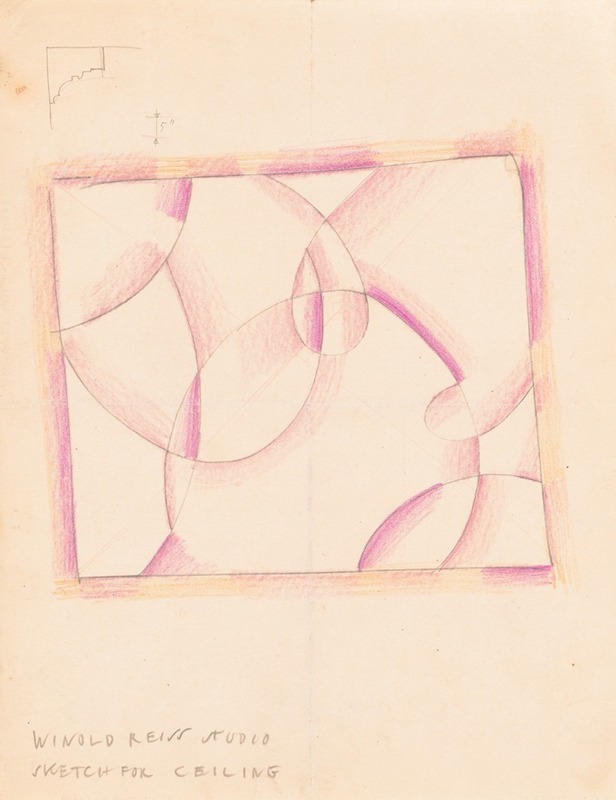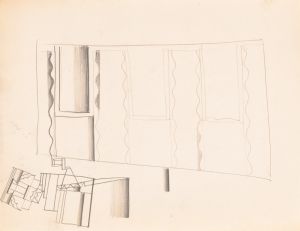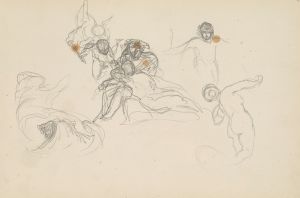
Interior designs for screens and ceilings.] [Drawing of plans, elevation, and details
A hand-painted replica of Winold Reiss’s masterpiece Interior designs for screens and ceilings.] [Drawing of plans, elevation, and details, meticulously crafted by professional artists to capture the true essence of the original. Each piece is created with museum-quality canvas and rare mineral pigments, carefully painted by experienced artists with delicate brushstrokes and rich, layered colors to perfectly recreate the texture of the original artwork. Unlike machine-printed reproductions, this hand-painted version brings the painting to life, infused with the artist’s emotions and skill in every stroke. Whether for personal collection or home decoration, it instantly elevates the artistic atmosphere of any space.
Winold Reiss (1886-1953) was a German-American artist and designer known for his contributions to interior design, particularly in the early 20th century. His work often included detailed plans, elevations, and intricate details for various architectural elements, including screens and ceilings. Reiss's designs were characterized by their meticulous craftsmanship and attention to detail, reflecting his training and background in both fine arts and applied arts.
Reiss was born in Karlsruhe, Germany, and studied at the Royal Academy of Fine Arts in Munich. He immigrated to the United States in 1913, where he quickly established himself as a prominent figure in the American art and design scene. His work spanned various mediums, including painting, illustration, and interior design. Reiss was particularly noted for his portraits of Native Americans and African Americans, which were celebrated for their respectful and dignified representation of his subjects.
In the realm of interior design, Reiss's contributions were significant. He was involved in several high-profile projects, including the design of the interiors for the Cincinnati Union Terminal, a landmark Art Deco train station completed in 1933. His work for the terminal included murals, mosaics, and other decorative elements that showcased his ability to blend artistic creativity with functional design.
The "Interior designs for screens and ceilings" by Winold Reiss likely refers to his detailed architectural drawings that were used in various projects. These drawings would have included plans, elevations, and intricate details that guided the construction and decoration of interior spaces. Reiss's designs often featured geometric patterns, vibrant colors, and a harmonious balance between form and function. His work was influenced by various artistic movements, including Art Deco and Modernism, which were popular during his career.
Reiss's approach to design was holistic, considering not only the aesthetic appeal but also the practical aspects of the spaces he worked on. His drawings would have served as blueprints for craftsmen and builders, ensuring that his vision was accurately translated into the final product. The attention to detail in his drawings reflects his commitment to quality and his deep understanding of both artistic principles and architectural requirements.
Throughout his career, Reiss collaborated with various architects, designers, and institutions, leaving a lasting impact on the field of interior design. His work remains influential, and his designs are studied and admired for their innovation and artistic merit. Reiss's legacy is preserved through his numerous projects and the continued appreciation of his contributions to art and design.
In summary, Winold Reiss was a multifaceted artist whose interior designs for screens and ceilings exemplify his skill and creativity. His detailed drawings provided a foundation for the construction of aesthetically pleasing and functional spaces, reflecting his expertise in both art and architecture. Reiss's work continues to be celebrated for its beauty, precision, and enduring influence on the field of interior design.





![Graphic designs for the Presidents Room of the ‘Knickerbocker’ Longchamps Restaurant, 41st Street and 1450 Broadway, New York, NY.] [Portrait of Lincoln](/imgs/249258/s/winold-reiss-graphic-designs-for-the-presidents-room-of-the-knickerbocker-longchamps-restaurant-41st-street-and-1450-broadway-new-york-ny-portrait-of-lincoln-e2174e99.jpg)
![[Interior design drawings for unidentified rooms.] [Sketch for hallway colored green and purple](/imgs/249268/s/winold-reiss-interior-design-drawings-for-unidentified-rooms-sketch-for-hallway-colored-green-and-purple-4dbe0353.jpg)
![[Interior design drawings for unidentified rooms.] [Sketch for room colored green and orange](/imgs/249269/s/winold-reiss-interior-design-drawings-for-unidentified-rooms-sketch-for-room-colored-green-and-orange-9a5c830b.jpg)
![Design for fine art print, ‘The Mad Dancer’.] [Woodcut print](/imgs/249286/s/winold-reiss-design-for-fine-art-print-the-mad-dancer-woodcut-print-c03b5ea2.jpg)
![Interior design drawings for unidentified rooms.] [Sketch for unidentified room with silver wall and ceiling](/imgs/249362/s/winold-reiss-interior-design-drawings-for-unidentified-rooms-sketch-for-unidentified-room-with-silver-wall-and-ceiling-af719bb9.jpg)
![Interior design drawings for unidentified rooms.] [Sketch for unidentified room with starred walls](/imgs/249363/s/winold-reiss-interior-design-drawings-for-unidentified-rooms-sketch-for-unidentified-room-with-starred-walls-78931be1.jpg)

![Drawings for proposed decorations of Mike Lyman’s Restaurant, 424 W. Sixth St., Los Angeles, CA.] [Drawing #10, Scheme 1; Color scheme for ceiling – main dining room](/imgs/249426/s/winold-reiss-drawings-for-proposed-decorations-of-mike-lymans-restaurant-424-w-sixth-st-los-angeles-ca-drawing-10-scheme-1-color-scheme-for-ceiling-main-dining-room-6113fb5a.jpg)
![Interior designs for screens and ceilings.] [Drawing of plans, elevation, and details](/imgs/249429/s/winold-reiss-interior-designs-for-screens-and-ceilings-drawing-of-plans-elevation-and-details-228c6d94.jpg)




